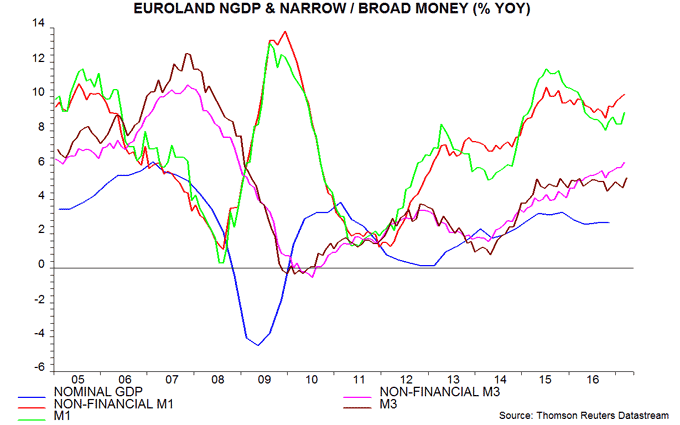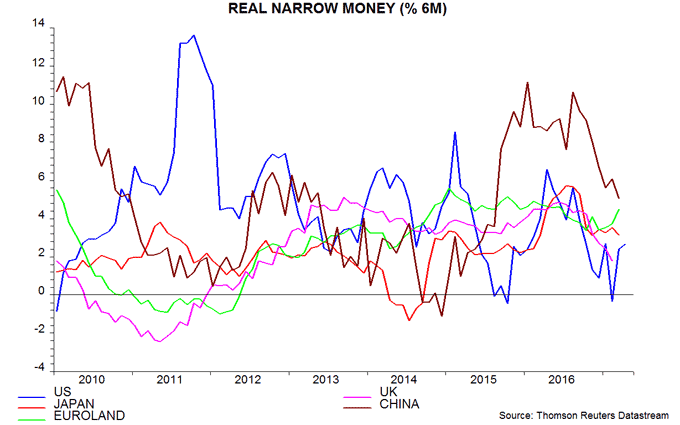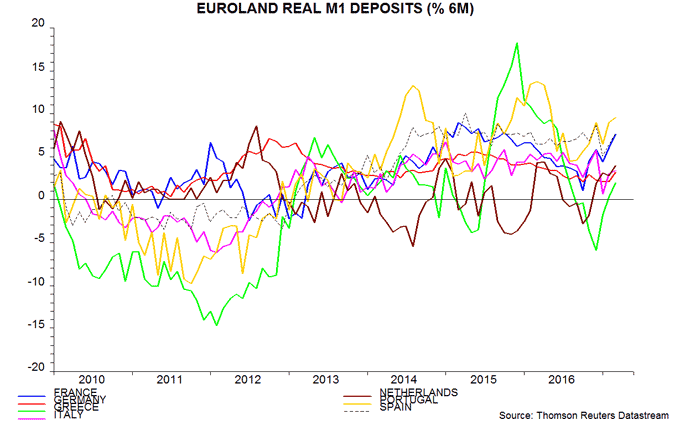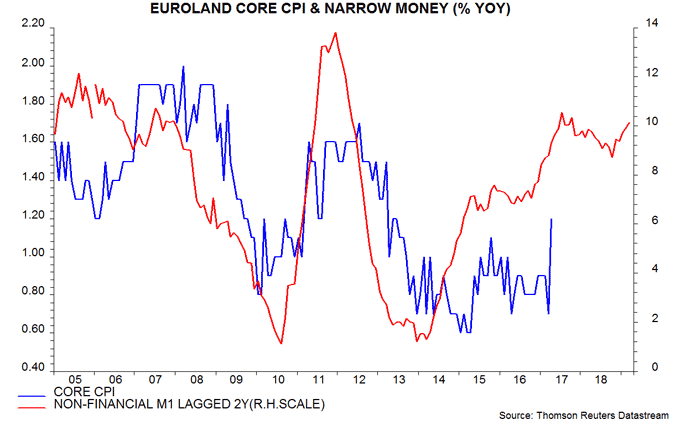Entries from April 23, 2017 - April 29, 2017
Euroland money numbers strong, ECB ignoring "monetary pillar"
Euroland monetary trends continued to strengthen in March, suggesting solid economic prospects and increasing danger of a 2018-19 inflation overshoot. The ECB’s strategy seems to be to try to delay any meaningful withdrawal of monetary stimulus until after Italian parliamentary elections expected in early 2018 but policy could by then be far “behind the curve”.
Annual growth in the headline M3 broad aggregate rose to 5.3% in March, exceeding a previous high of 5.2% reached in several months in 2015-16. Narrow money M1 growth increased to 9.1%, a 10-month high. The headline measures, however, understate monetary looseness because their growth has been depressed by a fall in money holdings of financial institutions over the past 12 months, probably related to negative rates, which has no adverse implication for economic prospects. The preferred broad and narrow money aggregates here are “non-financial” M3 and M1, comprising holdings of households and non-financial corporations. Annual growth of non-financial M3 rose to 6.1% in March, the fastest since 2008, with non-financial M1 growth at 10.1%, a 17-month high. The continued acceleration of the two aggregates suggests that annual nominal GDP growth will move up towards 4% in late 2017 / 2018 – see first chart.
Prospects for economic activity depend on real (i.e. inflation-adjusted) rather than nominal monetary trends. Six-month growth rates of the non-financial money measures deflated by consumer prices (seasonally adjusted) rose strongly in March but are lower than a year ago and roughly in the middle of their ranges over the past three years – second chart. Real money trends, therefore, are consistent with a continuation of GDP growth at its recent pace of 1.5-2% per annum. Relative monetary strength, in other words, suggests that Euroland activity will be insulated from an expected loss of global economic momentum over the summer / autumn – third chart.

The country breakdown of narrow money (i.e. overnight) deposits shows strong real growth in Portugal, Spain and France, with Germany and Italy lagging – fourth chart. Lacklustre Italian economic prospects may help to explain ECB President Draghi’s determination to hold the hawks at bay until after elections. French monetary strength suggests the potential for a sharp rebound in GDP growth – officially estimated at 0.3% in the first quarter – as political uncertainty abates. A resumption of real money expansion in Greece, meanwhile, may herald improving economic prospects.
In other Euroland news today, annual “core” consumer price inflation – i.e. excluding energy, food, alcohol and tobacco – jumped from 0.7% in March to 1.2% in April, reflecting Easter timing distortions. Core inflation will probably fall back again in May but the lagged relationship with narrow money growth suggests a rising trend into 2018-19 – fifth chart.
Global growth strong but peaking
Monetary trends in mid to late 2016 suggested that global economic growth would surprise positively in early 2017 but momentum would peak in the spring and slow significantly over the summer (see, for example, here). Recent “soft” economic news (i.e. diffusion indices from business and consumer surveys) has been buoyant, consistent with the forecast, but some “hard” information (i.e. official quantitative data) has lagged – particularly in the US, where GDP may have grown by only 0.5% at an annualised rate in the first quarter, according to the Atlanta Fed. The expectation here is that the weakness in some hard data series will be reversed in the second quarter but that soft news is now peaking and will moderate into mid-year. Both soft and hard data are then likely to weaken through late 2017. Near-term strength in hard data may pose a risk to markets because it will reinforce a shift towards tighter monetary policies at a time when underlying economic momentum is starting to fade.
Most hard data news has, in fact, been solid, if less buoyant than survey evidence. The global industrial output measure tracked here – covering the G7 economies and seven large emerging economies (the “E7”) – is estimated to have risen at a 3.2% annualised pace in the first quarter of 2017. The US has contributed to this performance, with manufacturing output growing by 2.8% annualised, the fastest since 2014.
The long-standing forecast here has been that six-month growth of G7 plus E7 industrial output would peak in the second quarter, possibly in May, and moderate through the third quarter. This reflects a fall in six-month real narrow money growth from a peak in August 2016 – real money growth turning points have led those in output growth by an average of nine months historically. Real money growth reached a low in December 2016 and appears to have rebounded sharply in March, based on partial data – see first chart. This profile, however, partly reflects India’s demonetisation programme, implemented in early November, which resulted in an immediate plunge in narrow money M1 followed by a V-shaped recovery. The third line in the first chart shows an adjusted real money growth series that attempts to iron out this volatility by holding Indian narrow money stable at its October level. This measure reached a low in February, with an estimated small recovery in March. Both the unadjusted and adjusted measures remain significantly below the August 2016 peak. Monetary trends, therefore, continue to signal a weaker economic outlook, with industrial output growth likely to slow through late 2017 (based on the February trough in the adjusted measure).
Confidence here in an imminent reversal of economic momentum has been reinforced by recent OECD leading indicator data (published for February and estimated for March). Six-month growth of a composite G7 plus E7 indicator derived from the OECD country data appears to have peaked in January, with one-month growth falling for a fourth consecutive month in March – second chart. Leading indicator growth turning points have led those in industrial output growth by four to five months on average historically, so this aligns with the monetary forecast that six-month output expansion will top out around May.
The next stage of the scenario should be a fading of business survey strength. The third chart shows a composite G7 plus E7 survey indicator that combines diffusion indices for new orders or output expectations, mostly for the industrial sector. This measure is closely correlated with the widely-monitored Markit global manufacturing purchasing managers’ index (for which a hefty subscription is required for data access) and – like the PMI – has been a coincident to very short leading indicator historically (albeit benefiting from a short publication lag). The indicator may have peaked out in February / March, consistent with a May peak in six-month output expansion.
A softening of business surveys would be expected to be accompanied by a less favourable balance of revisions of company earnings forecasts by equity analysts. The G7 plus E7 business survey indicator correlates closely with the MSCI All Country World Index (ACWI) earnings revisions ratio (seasonally adjusted), which has moderated from a February peak – fourth chart.
The recovery in global six-month real narrow money growth in March suggests that the coming slowdown in economic momentum will bottom out in late 2017 but more evidence is required before adopting this as a central scenario.
The above forecast contrasts with the mood of optimism at the IMF spring meeting of the global policy-making elite and the opinion of the FT’s chief economics commentator, who states that “[t]he world economy is improving” and “[t]here is now a reasonable chance of a cyclical recovery”. The Keynesian consensus, of course, was pessimistic nine months ago as the economy was gaining momentum in line with earlier monetary strength.

